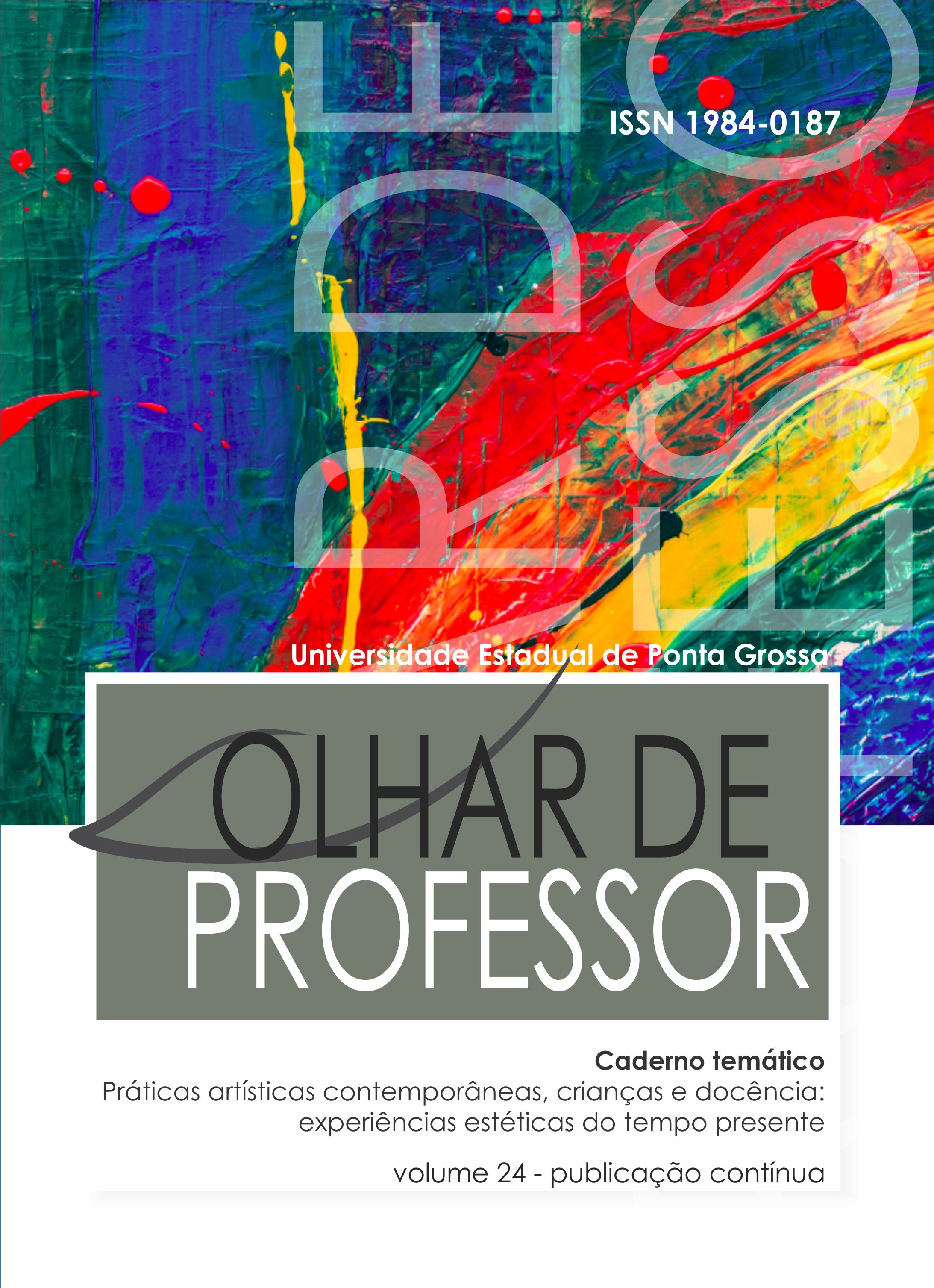The child speaks: the drawing as source of listening and artistic production about their favorite play in the school routine of children's education
Main Article Content
Abstract
This article presents a discussion on the importance of careful listening to children in research and the drawing as source of artistic production about their favorite play in the school routine of Children's Education. The aim of this study is to present production of drawings made by children to represent their favorite play and discuss the importance of the play for the children's development through theoretical foundation of historical-cultural psychology. The methodology used was qualitative research based on historical-cultural approach, chat groups were conducted and registers of the drawings made by the children about their favorite play were made. As a result, it was possible to widen concepts about the participation of the child in Children's Education, which were analyzed based on the opinions of both the children and the adults, making it possible for the researchers to reflect on the spaces and moments dedicated to the play in the school routine of Children's Education.
Downloads
Article Details
Authors who publish in this journal agree with the following terms:
a) Authors keep the copyrights and concede the right of its first publication to the magazine. The work piece must be simultaneously licensed on the Creative Commons Attribution License which allows the paper sharing, and preserves both the author identity and the right of first publication to this magazine.
b) Authors are authorized to assume additional contracts separately, to not-exclusively distribution of the paper version published in this magazine (e.g.: publish in institutional repository or as a book chapter), with the author identity recognition and its first publication in this magazine.
c) Authors are permitted and stimulated to publish and distribute their papers online (e.g.: in institutional repository or on their personal webpage), considering it can generate productive alterations, as well as increase the impact and the quotations of the published paper.
d) This journal provides public access to all its content, as this allows a greater visibility and reach of published articles and reviews. For more information on this approach, visit the Public Knowledge Project, a project that developed this system to improve the academic and public quality of the research, distributing OJS as well as other software to support the publication system of public access to academic sources.
e) The names and e-mail addresses on this site will be used exclusively for the purposes of the journal and are not available for other purposes.

This work is licensed under a Creative Commons Attribution 4.0 International License.
References
EDWARDS, Carolyn; GANDINI, Lella; FORMAN, George. As cem linguagens da criança: a abordagem de Reggio Emilia na Educação da primeira infância. Porto Alegre: Penso, 2016.
ELKONIN, D. B. Psicologia do jogo. São Paulo: Martins Fontes, 2009.
FONTANA, Roseli.; CRUZ, Nazaré. Psicologia e trabalho pedagógico. São Paulo: Atual, 1997.
FRANCO, R. R. A fundamentação jurídica do direito de brincar. 2008. 253f. Dissertação (Mestrado em Educação). Universidade Estadual de Londrina, Londrina, 2008.
GOBBI, M. Lápis vermelho é de mulherzinha: Desenho infantil, relações de gênero e crianças pequenas. Pró-posições. Vol. 10, no. 1, março de 1999. Disponível em: https://www.fe.unicamp.br/pf-fe/publicacao/1999/28-artigos-gobbim.pdf. Acesso em 2 de junho de 2019.
IAVELBERG, R. O desenho cultivado da criança. Porto Alegre: Editoura Zouk, 2013.
LACERDA, C. B. F. Oralidade, desenho e escrita: o processo de construção do conhecimento. São Paulo: Cabral editora. 1995.
LEONTIEV, A. N. Os princípios psicológicos da brincadeira pré-escolar. IN: VIGOTSKII, L.S.; LURIA, A. R.; LEONTIEV, A. N. Linguagem, desenvolvimento e aprendizagem. 6 ed. São Paulo: Ícone editora, 2010. p. 119-142.
LONGO, C. S. NARITA, S. Psicologia do desenho infantil: uma proposta na perspectiva histórico-cultural. Rev. Psicologia.pt. p. 1-11, 2018. Disponível em: https://www.psicologia.pt/artigos/ver_artigo.php?psicologia-do-desenho-infantil-uma-proposta-na-perspectiva-historico-cultural&codigo=A1272&area=d10 . Acesso em 13 de mar. de 2021.
MELLO, M. A. Diferenças conceituais e pedagógicas entre brincadeira e jogo na teoria histórico-cultural: implicações no ensino e na aprendizagem na educação infantil. Tese (Acadêmica Inédita). UFSCAR: São Carlos, 2018.
MINAYO, Maria Cecília de Souza. Análise qualitativa: teoria, passos e fidedignidade. Cienc. Saúde Coletiva, v.17, n.3, p.621-625, 2012.
MOURA, E. A.; MATA, M. S.; PAULINO, P. R.V.; FREITAS, A. P.; JUNIOR, C. A. M.; MÁRMORA, C. H. C. Os planos genéticos do desenvolvimento humano: A contribuição de Vigotski. Revista de ciências humana de Unitau. Vol. 10, n. 1, p.106-114, 2016. Disponível em: http://www.rchunitau.com.br/index.php/rch/article/view/298. Acesso em 01 de jun. de 2018.
NATIVIDADE, M. R. COUTINHO, M. C. ZANELLA, A. V. Desenho na pesquisa com crianças: análise na perspectiva histórico-cultural. Rev. Contextos Clínicos. p. 9-18, 2008. Disponível em: http://pepsic.bvsalud.org/scielo.php?script=sci_abstract&pid=S1983-34822008000100002&lng=pt&nrm=iso. Acesso em 13 de mar. de 2021.
PILLOTTO, S. S. D.; SILVA, M. K.; MOGNOL, L. T. Grafismo infantil: linguagem do desenho. UDESC, 2007. Disponível em: http://revistas.udesc.br/index.php/linhas/article/viewFile/1219/1033. Acesso em 02 de junho de 2019.
ROCHA, Maria Silvia Pinto de Moura Librandi. Não brinco mais: a (des)construção do brincar no cotidiano educacional. Ijuí: Ed. Unijuí, 2005.
SILVA, M. C. S. Condições sociais da constituição do desenho infantil. Psicol. USP. 1998, v.9, n.2, p. 205-220. Disponível em: http://dx.doi.org/10.1590/S0103-65641998000200008. Acesso em 06 de abril de 2019.
SILVA, P. R.; SOUZA, F. C.; OLIVEIRA, R. C. D. Os direitos das crianças pequenas: do silêncio ao grito. In: SANTOS, M. W.; TOMAZZETTI, C. M.; MELLO, S. A. (orgs.) Eu ainda sou criança: educação infantil e resistência. São Carlos: EdUFSCar, 2018. p. 81-90.
VIGOTSKI, L. S. A formação social da mente: o desenvolvimento dos processos psicológicos superiores. São Paulo: Martins Fontes, 2007.
VIGOTSKI, L. S. Imaginação e criação na infância. São Paulo: Ática, 2009.
VIGOTSKI, L. S. Psicologia pedagógica. São Paulo: WMF Martins Fontes, 2010.





